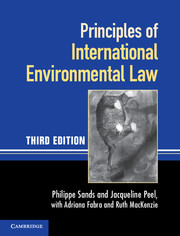Book contents
- Frontmatter
- Contents
- Foreword
- Preface and acknowledgments to the first edition
- Preface and acknowledgments to the second edition
- Preface and acknowledgments to the third edition
- Table of cases
- Table of treaties and other international instruments
- Abbreviations
- Part I The legal and institutional framework
- Part II Principles and rules establishing standards
- Part III Techniques for implementing international principles and rules
- Part IV Linkage of international environmental law and other areas of international law
- Index
Foreword
Published online by Cambridge University Press: 05 June 2012
- Frontmatter
- Contents
- Foreword
- Preface and acknowledgments to the first edition
- Preface and acknowledgments to the second edition
- Preface and acknowledgments to the third edition
- Table of cases
- Table of treaties and other international instruments
- Abbreviations
- Part I The legal and institutional framework
- Part II Principles and rules establishing standards
- Part III Techniques for implementing international principles and rules
- Part IV Linkage of international environmental law and other areas of international law
- Index
Summary
Foreword
It is with pleasure that I write a foreword to this timely exposition and analysis of the system of environmental law as a whole, and as it stands after the Rio Conference. If it seems a little bold to call environmental law a ‘system’, it is assuredly not so bold as it would have been before the publication of Philippe Sands' important work. A main purpose of academic writing should be to perceive and portray patterns and relations in a body of legal rules so as to make it manageable, teachable, comprehensible and usable. The present work succeeds in doing this to a remarkable degree.
The author's statement that environmental law has a ‘longer history than some might suggest’ might be thought to border on understatement. When something is taken up as a modish ‘concern’, there is often a strong temptation to think of it as a discovery by a newly enlightened generation. It is, therefore, a useful antidote to be reminded that, of the two pioneering decisions, both still leading and much-cited cases, one was the Bering Sea arbitration, of a century ago, and the other, the Trail Smelter arbitration, of half a century ago. Nevertheless, the present-day need for law to protect the environment and to preserve resources is of a scale and urgency far beyond the imagining of the early pioneers.
- Type
- Chapter
- Information
- Principles of International Environmental Law , pp. xxi - xxivPublisher: Cambridge University PressPrint publication year: 2012



